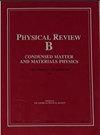Spirit : Multifunctional framework for atomistic spin simulations
IF 3.2
2区 物理与天体物理
Q2 MATERIALS SCIENCE, MULTIDISCIPLINARY
引用次数: 84
Abstract
The \textit{Spirit} framework is designed for atomic scale spin simulations of magnetic systems of arbitrary geometry and magnetic structure, providing a graphical user interface with powerful visualizations and an easy to use scripting interface. An extended Heisenberg type spin-lattice Hamiltonian including competing exchange interactions between neighbors at arbitrary distance, higher-order exchange, Dzyaloshinskii-Moriya and dipole-dipole interactions is used to describe the energetics of a system of classical spins localised at atom positions. A variety of common simulations methods are implemented including Monte Carlo and various time evolution algorithms based on the Landau-Lifshitz-Gilbert equation of motion, which can be used to determine static ground state and metastable spin configurations, sample equilibrium and finite temperature thermodynamical properties of magnetic materials and nanostructures or calculate dynamical trajectories including spin torques induced by stochastic temperature or electric current. Methods for finding the mechanism and rate of thermally assisted transitions include the geodesic nudged elastic band method, which can be applied when both initial and final states are specified, and the minimum mode following method when only the initial state is given. The lifetime of magnetic states and rate of transitions can be evaluated within the harmonic approximation of transition-state theory. The framework offers performant CPU and GPU parallelizations. All methods are verified and applications to several systems, such as vortices, domain walls, skyrmions and bobbers are described.Spirit:原子自旋模拟的多功能框架
\textit{Spirit}框架是为任意几何形状和磁性结构的磁性系统的原子级自旋模拟而设计的,它提供了一个具有强大可视化功能和易于使用的脚本界面的图形用户界面。使用扩展的海森堡型自旋晶格哈密顿量,包括任意距离邻居之间的竞争交换相互作用、高阶交换、Dzyaloshinskii-Moriya和偶极-偶极相互作用,来描述位于原子位置的经典自旋系统的能量学。实现了各种常见的模拟方法,包括蒙特卡罗和基于Landau-Lifshitz-Gilbert运动方程的各种时间演化算法,这些算法可用于确定静态基态和亚稳态自旋构型,采样磁性材料和纳米结构的平衡和有限温度热力学性质,或者计算包括由随机温度或电流引起的自旋力矩的动力学轨迹。寻找热辅助跃迁机制和速率的方法包括测地线轻推弹性带方法,该方法可在指定初始和最终状态时应用,以及当仅给定初始状态时的最小模式跟随方法。磁态的寿命和跃迁速率可以在跃迁态理论的谐波近似中进行评估。该框架提供了高性能的CPU和GPU并行化。验证了所有方法,并描述了其在涡流、畴壁、skyrmions和浮子等系统中的应用。
本文章由计算机程序翻译,如有差异,请以英文原文为准。
求助全文
约1分钟内获得全文
求助全文
来源期刊

Physical Review B
PHYSICS, CONDENSED MATTER-
CiteScore
6.30
自引率
32.40%
发文量
4177
期刊介绍:
Physical Review B (PRB) is the world’s largest dedicated physics journal, publishing approximately 100 new, high-quality papers each week. The most highly cited journal in condensed matter physics, PRB provides outstanding depth and breadth of coverage, combined with unrivaled context and background for ongoing research by scientists worldwide.
PRB covers the full range of condensed matter, materials physics, and related subfields, including:
-Structure and phase transitions
-Ferroelectrics and multiferroics
-Disordered systems and alloys
-Magnetism
-Superconductivity
-Electronic structure, photonics, and metamaterials
-Semiconductors and mesoscopic systems
-Surfaces, nanoscience, and two-dimensional materials
-Topological states of matter
 求助内容:
求助内容: 应助结果提醒方式:
应助结果提醒方式:


